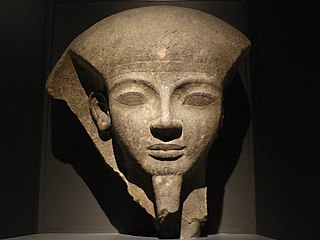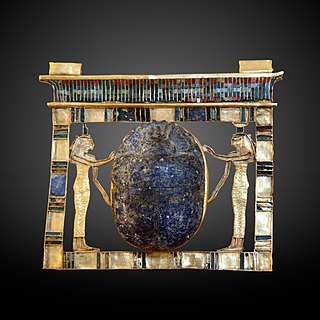
The Philistines were an ancient people who lived on the south coast of Canaan during the Iron Age in a confederation of city-states generally referred to as Philistia.

Canaan was a Semitic-speaking civilization and region of the Southern Levant in the Ancient Near East during the late 2nd millennium BC. Canaan had significant geopolitical importance in the Late Bronze Age Amarna Period as the area where the spheres of interest of the Egyptian, Hittite, Mitanni, and Assyrian Empires converged or overlapped. Much of present-day knowledge about Canaan stems from archaeological excavation in this area at sites such as Tel Hazor, Tel Megiddo, En Esur, and Gezer.

Hatmehit or Hatmehyt was an Ancient Egyptian goddess associated with the city in the Nile Delta known as Djedet or Mendes.

The Sea Peoples were a group of tribes hypothesized to have attacked Egypt and other Eastern Mediterranean regions around 1200 BC during the Late Bronze Age. The hypothesis was first proposed by the 19th century Egyptologists Emmanuel de Rougé and Gaston Maspero, on the basis of primary sources such as the reliefs on the Mortuary Temple of Ramesses III at Medinet Habu. Subsequent research developed the hypothesis further, attempting to link these sources to other Late Bronze Age evidence of migration, piracy, and destruction. While initial versions of the hypothesis regarded the Sea Peoples as a primary cause of the Late Bronze Age collapse, more recent versions generally regard them as a symptom of events which were already in motion before their purported attacks.

The New Kingdom, also called the Egyptian Empire, refers to ancient Egypt between the 16th century BC and the 11th century BC. This period of ancient Egyptian history covers the Eighteenth, Nineteenth, and Twentieth dynasties. Through radiocarbon dating, the establishment of the New Kingdom has been placed between 1570 BC and 1544 BC. The New Kingdom followed the Second Intermediate Period and was succeeded by the Third Intermediate Period. It was the most prosperous time for the Egyptian people and marked the peak of Egypt's power.

Ramesses VI Nebmaatre-Meryamun was the fifth ruler of the Twentieth Dynasty of Egypt. He reigned for about eight years in the mid-to-late 12th century BC and was a son of Ramesses III and queen Iset Ta-Hemdjert. As a prince, he was known as Ramesses Amunherkhepeshef and held the titles of royal scribe and cavalry general. He was succeeded by his son, Ramesses VII Itamun, whom he had fathered with queen Nubkhesbed.

The Peleset or Pulasati are a people appearing in fragmentary historical and iconographic records in ancient Egyptian from the Eastern Mediterranean in the late 2nd millennium BCE. They are hypothesised to have been one of the several ethnic groups of which the invading Sea Peoples were said to be composed. Today, historians generally identify the Peleset with the Philistines.

Senusret I also anglicized as Sesostris I and Senwosret I, was the second pharaoh of the Twelfth Dynasty of Egypt. He ruled from 1971 BC to 1926 BC, and was one of the most powerful kings of this Dynasty. He was the son of Amenemhat I. Senusret I was known by his prenomen, Kheperkare, which means "the Ka of Re is created." He expanded the territory of Egypt allowing him to rule over an age of prosperity.

Khasekhemre Neferhotep I was an Egyptian pharaoh of the mid Thirteenth Dynasty ruling in the second half of the 18th century BC during a time referred to as the late Middle Kingdom or early Second Intermediate Period, depending on the scholar. One of the best attested rulers of the 13th Dynasty, Neferhotep I reigned for 11 years according to the Turin King List.
Serapis or Sarapis is a Graeco-Egyptian god. A syncretic deity derived from the worship of the Egyptian Osiris and Apis, Serapis was extensively popularized in the third century BC on the orders of Greek Pharaoh Ptolemy I Soter, as a means to unify the Greek and Egyptian subjects of the Ptolemaic Kingdom.

Paser was an ancient Egyptian noble who served as vizier during the reigns of Seti I and Ramesses II in the 19th Dynasty. He would later also become High Priest of Amun.
Seti or Suti was an ancient Egyptian soldier during the late 18th Dynasty, the commander of the army, later mentioned as vizier on monuments of his son, Pharaoh Ramesses I. Seti, the forefather of the 19th Dynasty, was from a military family in the Nile Delta. According to one theory he is identical with a royal envoy mentioned in the Amarna letters as Shuta.

Iymeru Neferkare was the ancient Egyptian vizier under king Sobekhotep IV in the 13th Dynasty, in the Second Intermediate Period.
This page list topics related to ancient Egypt.

Setka is the name of an ancient Egyptian crown prince. He is known for his statuette in the shape of a seated scribe. He is also the subject of a theory that claims he was pharaoh of Egypt for a very short time.

Wenennefer was an ancient Egyptian High Priest of Osiris at Abydos, during the reign of pharaoh Ramesses II of the 19th Dynasty.
Minmose was the High Priest of Anhur during the reign of Ramesses II
The Theban Tomb TT414 is located in El-Assasif, part of the Theban Necropolis, on the west bank of the Nile, opposite to Luxor. The tomb was originally constructed in the El-Assasif necropolis for the use of Ankh-hor and his family. Ankhor was the Chief Steward to the God's Wife Nitocris during the 26th Dynasty. Ankh-hor is dated to the reigns of Pharaohs Psamtik II and Apries. The tomb was later usurped during the 30th Dynasty and the Ptolemaic Period.

The Statuette of the lady Tiye is a wooden statue of a high-status woman from the reign of Amenhotep III to Akhenaten ; Dynasty 18 of the New Kingdom of ancient Egypt. Believed to depict a leading servant of the powerful Great Royal Wife Tiye, her title has been variously translated over the years as "Chief of Weavers" / "Chief of the Household" / "mistress of the harim". It is one of only about 160 wooden statues discovered from the New Kingdom. It currently resides in the Metropolitan Museum of Art.

The Mysteries of Osiris, also known as Osirism, were religious festivities celebrated in ancient Egypt to commemorate the murder and regeneration of Osiris. The course of the ceremonies is attested by various written sources, but the most important document is the Ritual of the Mysteries of Osiris in the Month of Khoiak, a compilation of Middle Kingdom texts engraved during the Ptolemaic period in an upper chapel of the Temple of Dendera. In Egyptian religion, the sacred and the secret are intimately linked. As a result, ritual practices were beyond the reach of the uninitiated, as they were reserved for the priests, the only ones authorised to enter the divine sanctuaries. The most unfathomable theological mystery, the most solemnly precautionary, is the remains of Osiris. According to the Osirian myth, this mummy is kept deep in the Duat, the subterranean world of the dead. Every night, during his nocturnal journey, Ra, the solar god, came there to regenerate by temporarily uniting with Osiris in the form of a single soul.
















